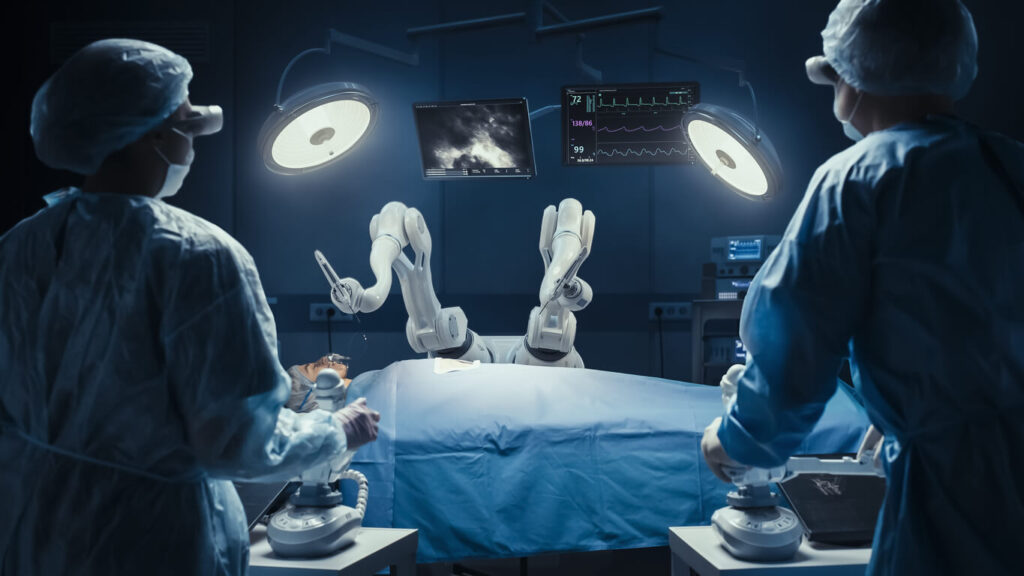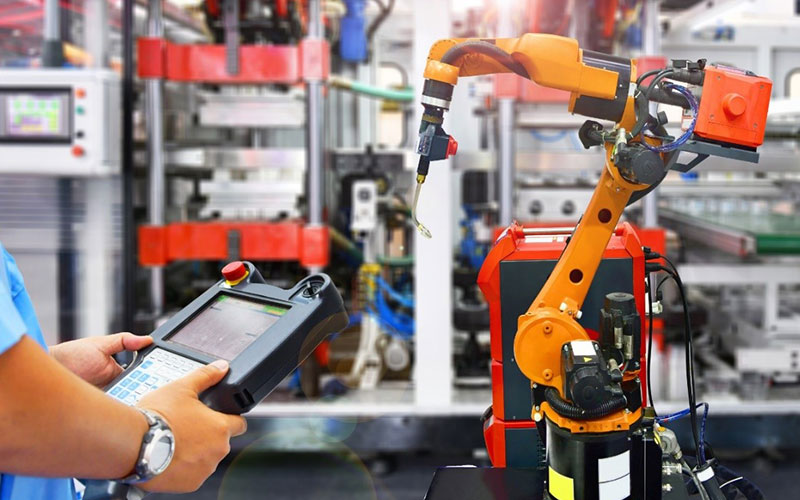What are Cobots?
Collaborative robots or “cobots” are types of industrial robots that have been designed to communicate with and operate alongside humans in the workplace. Cobots are not built to replace humans but rather to augment and enhance human capabilities. In doing so, they provide increased strength, improved data capabilities and more accurate precision that will help transform several industries.
Cobots offer a host of advantages that make them ideal for working alongside human operators – they are lightweight, smaller in size and energy-efficient. By definition, they are collaborative, enabled with constructional and operational mechanisms to qualify as a safe companion for co-working in the same time and space as human operators.
“The future of testing: automation and collaborative robots” Vivek Jaykrishnan, Senior Director of Technology, Digital Engineering & Manufacturing Services, Capgemini
Game-Changing Benefits of Collaborative Robots
Advantages of using cobots:
- Increased productivity – cobots do not need a break; they can operate continuously, resulting in longer production runs and shorter cycle times. Additionally, they can perform monotonous tasks, releasing human workers to do more fulfilling jobs.
- Improved quality – cobots’ precision and consistency result in higher product quality and reduced defects. They can perform tasks with minimal variation, contributing to better overall quality control.
- Enhanced safety – cobots are designed to work safely alongside humans. They are equipped with safety features to prevent accidents.
- Flexibility – they are easily reprogrammable and adaptable to evolving product lines and production requirements.
- Cost savings – although it is a one-time expense, an investment in cobots can result in lower labour costs, more efficiency, and fewer errors over the long run.
- Space efficiency – cobots are often compact and can work in small areas, maximising production.
- Quick integration – they can be integrated into existing systems with minimal downtime during implementation.
- Worker empowerment – cobots assist human workers by freeing them up to concentrate on jobs that call for ingenuity and problem-solving.
- Competitive advantage – businesses that use cobot technology can cut expenses associated with operations while increasing production, quality, and efficiency.
Top 8 Industries Benefiting from Cobots
Cobots are being used extensively across a number of diverse industries, including:
1. Automotive
Cobots have completely changed the automotive sector by increasing output, raising standards of quality, and bolstering security. Cobots complement human operators by enhancing their efficiency in precise and repetitive activities. Their versatility enables them to quickly adapt to shifting production requirements, and their cutting-edge features prioritise safety. While cobots take more precision in the execution of tasks such as component handling, fastening, and inspections, human workers can concentrate on more difficult tasks.
Cobots effortlessly integrate into digital production processes, providing a glimpse of an even more vital role in the industry’s future as Industry 5.0 ideas gain traction. Among the financial advantages are long-term improvements in productivity and quality, even if they do need an upfront investment.
2. Healthcare and Pharmaceutical

Over the last few years, the healthcare industry has become increasingly digitised with the introduction of e-prescriptions, automated billing and electronic medical records (discover all the top technology trends in the healthcare industry here). The use of collaborative robots has been no exception. Cobots have been transforming the healthcare industry in a number of ways by improving lab testing, providing automatic patient monitoring and assisting with surgery.
Cobots are used for a range of tasks, including carrying supplies throughout a hospital and monitoring patients, whose records are then automatically updated. This has been invaluable when dealing with the sheer quantity of cases during the pandemic, as nurses can monitor patients simultaneously and will be notified when human intervention is required. Cobots are ideal in biomedical applications that require sterile environments, which can be achieved more easily with robotics than with humans.
3. Logistics and Warehousing
Cobots are very common in warehouses. They easily collaborate with humans to complete orders more quickly and optimise supply chain procedures. They speed up the manufacturing process and are more precise than humans in picking, packing, and sorting. The popularity of industrial robots or robotic arms has grown in Industry 4.0, where automation greatly enhances production processes in smart factories. Industry 5.0 is more about collaboration rather than replacing and automating the workforce. Cobots are becoming more and more important as automation and e-commerce continue to transform the logistics industry.
4. Food production

In food production, work is usually carried out on a mass scale, meaning that plants would be unable to fulfil the volumes of product required without automation. Capable of use in a number of applications, cobots can be used to spray bread rolls, scan items and stack and pack products. Cobots also help to eliminate waste in food production as workers are more susceptible to error, especially when dealing with large quantities of delicate items such as eggs.
Collaborative robots are ideal in food production as they can work quickly in environments with unpleasant conditions, such as extreme temperatures and hazardous materials that may not be suitable for workers. By carrying out repetitive tasks, they also further promote health and safety as the risk of injury and strain on workers is reduced. With greater consistency, high quality and less risk of spoilage and contamination, cobots are increasingly becoming invaluable to the food industry in terms of both production and logistics.
5. Electronics
Collaborative robots are becoming essential tools for accuracy, productivity, and quality in the electronics sector. When accuracy is crucial, such as in soldering, circuit board assembly, and quality control, cobots perform very well. They complement human operators with ease, increasing output and decreasing mistakes. Their flexibility enables fast modifications to take into account changing production quantities and product standards. With advanced sensors and other safety measures, cobots and humans can work in a safe working environment. Cobots are essential to meeting the rising demand for electronics as the electronics industry develops due to technological advancements and miniaturisation.
6. Agriculture
Collaborative robotics in agriculture improve efficiency, guarantee accuracy, and support security. Cobots help farmers by assisting with monotonous tasks and streamlining operations. They effectively manage tasks like planting, harvesting, and sorting, allowing farmers to concentrate on more complex facets of their labour. Additionally, cobots provide long-term economic benefits through higher agricultural productivity and lower labour expenses, even after the initial investment. Cobots are expected to play an ever more significant part in agriculture’s embrace of automation and digitalisation, transforming farming in the process.
7. Construction
Working in the construction industry can take a toll on workers, given the hazardous environment, the need to lift heavy objects and the strains caused by repetitive tasks. With the introduction of cobots, however, many of these tasks can be automated, including wielding, laying bricks and pouring cement. Often, quality improves as a result of greater accuracy, assembly processes are completed more quickly, and the risk of personal injury is reduced.
8. All Manufacturing

Cobots have revolutionised production across a range of industries by increasing productivity and quality. Their proficiency in duties such as material handling, assembly, inspection, and packing enhance overall output. Their adaptability enables fast job reconfiguration to accommodate shifting production requirements.
Safety is the top priority in the manufacturing industry, and cobots with cutting-edge safety measures lower the number of accidents that occur at work. Additionally, they provide long-term economic benefits by lowering labour costs, decreasing errors, and improving product consistency, even with their initial costs.
Cobots Enhance the Workforce
Whilst some workers may be sceptical about the adoption of robots in the workplace and fear that their jobs are at risk, the same concerns are not applicable to cobots. Rather than replacing humans, collaborative robots work with them, undertaking repetitive tasks so that engineers and technicians can focus on more complex work that may require ingenuity and manual dexterity.
With additional resources required to operate and program cobots and with time saved by no longer carrying out repetitive tasks, automation often offers workers the opportunity to upskill, becoming more technical and progressive. Consequently, production lines are more efficient, improving workplace satisfaction and increasing productivity. However, to ensure that human-robot collaboration is successful and that these breakthroughs realise their full potential, training programmes are crucial.
Cobots, Industry 5.0 and the Future of Industry
Cobots are efficient, flexible and cost-effective. Equipped with smart technology, collaborative robots offer unrivalled sensing capabilities, making them aware of the people, location and context around them. As a collaborative device, cobots are optimised for safety so that they can work alongside humans safely and effectively.
As more companies embrace automation and artificial intelligence (AI), collaborative robots are becoming more commonplace and used in multiple sectors, from healthcare and agriculture to electronics and manufacturing. Edge computing is making cobots smarter, adding flexibility and leading the era of Industry 5.0, representing a symbiotic relationship between robots and humans. With human capabilities enhanced by collaborative robots, the factories of the future will be smarter and far more efficient.
For further information on cobots and to discover the exciting range of products that Distrelec offers, visit our website now.












